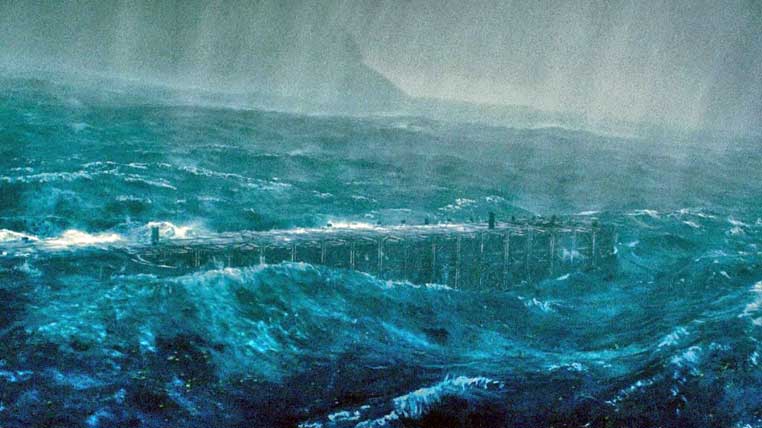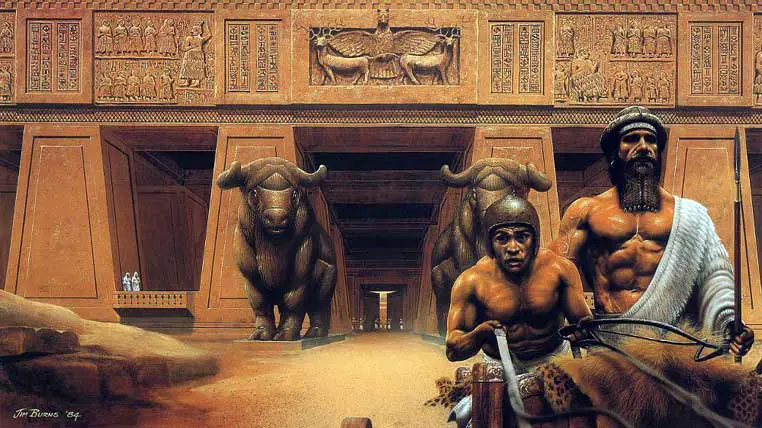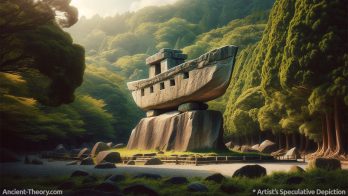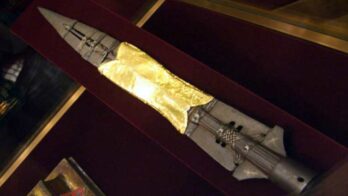While truly fascinating, the Sumerian civilization is not the only ancient civilization that appeared out of nowhere and reached an astonishing level of technological advancement for its time.
“Long ago, when the Earth was still soft.”
All the old legends of the North American Zuni Indians start with the exact traditional phrasing. The tribe elders attribute this insistence to the need to constantly remind people what the primordial state of the world was. A remarkable idea!
But how did the distant ancestors of the Zunis know that, more than 4 billion years ago, the Earth was just an immense mass of hot and viscous matter?
A Mysterious Civilization
The Sumerian civilization emerged in Mesopotamia, the “Land Between the Two Rivers” (Tigris and Euphrates), around 4000 BC.
The Sumerians stood out as superior to all other contemporary civilizations through their political-administrative organization, culture, and scientific knowledge.
Initially, there were several independent city-states, including Ur, Uruk, Babylon, Nippur, Lagas, Larsa, Kis, and Umma. Gradually, they formed alliances or were conquered by the strongest ones, creating the Sumerian kingdom.
The Akkad period (2300 – 2235 BC) and Ur II (2065-1955 BC) marked the peak of the kingdom’s power.
However, the nomadic Amorite tribes, allied with the Elamites, dealt a devastating blow to the Sumerian kingdom, resulting in its definitive disappearance from history in 1950 BC.
The Sumerian civilization’s legacy remains a historical enigma, as no evidence of gradual development or qualitative differences between the achievements of different periods of its existence has yet been discovered.
Constructions, works of art, and documents that remain show the same style and demonstrate the involvement of the same knowledge from the beginning to the collapse of Sumer, with insignificant changes occurring.
From a historical, economic, scientific, and logical point of view, this is an abnormal occurrence, although it is not the only exception.
Many ancient civilizations, such as the Egyptian, Mayan, and Inca, have suddenly and inexplicably appeared with highly advanced technological knowledge.
The Sumerians and Egyptians’ advanced scientific knowledge and refined artistic tastes during the Neolithic period (7500-2500 BC) are a mystery that no one can fully explain.
Unprecedented Technologies of the Time
The Sumerian civilization is renowned for developing one of the oldest types of writing, cuneiform writing, and building imposing temples known as ziggurats in the center of each important city.
Archaeological research has revealed the ruins of impressive temples, such as the great ziggurat of Ur, dating back to around 2000 BC.
The ziggurat was divided into seven levels, as the Sumerians believed that the gods needed seven days to travel between the kingdom of heaven and earth.
The king, who was also a high priest, officiated religious ceremonies and performed sacrifices on the altar at the top of the pyramid-shaped temple.
The Sumerian civilization also initiated the first systems of systematic irrigation in agriculture, invented the potter’s wheel (later the wheel of the chariot), and metal processing technology.
They made remarkable discoveries in mathematics, astronomy, and astrology.
The royal necropolis of Ur has revealed numerous objects made of a unique alloy of gold and silver (known as electrum), gold and lapis lazuli (an intensely blue precious stone), or bone and lapis lazuli.
However, this incredible knowledge and achievements are only a tiny part of the technological level at which the ancient Sumerian civilization is believed to have been.
Sumerians also invented the calendar, armor, writing, astronomy, irrigation systems, battle chariot, mills, harpoon, swords, horse harnesses, nails, sandals, chisel, needle, sieves, rings, and the potter’s wheel.
But one technology that belonged to the Sumerians surpasses all the others: the first electric battery.
The mechanism comprised a ceramic vessel in which a copper tube was inserted and fixed with a wooden plug.
An iron rod was passed through the plug’s center, and the vessel was then filled with lemon or orange juice. The resulting device, the Baghdad Battery, was then insulated with bitumen and could produce enough electricity to power a primitive machine.
Recent research has shown that the batteries developed by the Sumerians could be connected to each other, thereby providing an impressive power supply.
However, how the ancient Sumerians used electricity remains a great mystery.

The Mystery of the Sumerian Texts - The Song of Etana
The Sumerian civilization left numerous clay tablets using cuneiform writing (a primitive type of writing that appeared around 4000 BC) to record information of great scientific and historical interest.
These include religious or literary texts containing valuable historical and geographical data; economic, military, and dynastic archives; mathematics, physics, and astronomy calculations or formulas; laws and legal codes, whose first known draft in history took place in 2065 BC in Ur; administrative or technical records; legends and stories.
The texts were recorded on hundreds of thousands of tablets collected in the world’s first libraries discovered in royal palaces in Nippur (60,000 clay tablets), Ur (10,000 clay, bronze, and gold tablets), and in the Assyrian cities of Assur, founded by King Tiglatpalasar I (1112-1074 BCE) and Ninive, founded by King Assurbanipal (668-626 BCE), where 20,000 clay tablets and 500,000 clay, bronze, and wooden tablets were found, respectively.
The Assyrians eventually conquered the Sumerians, but they never reached their level of development.
One Sumerian poem of great artistic beauty was discovered, recorded on bronze plates, in the personal library of King Assurbanipal, beneath the ruins of his palace in Babylon.
The text states that the poem dates back to 4000 BCE but was first recorded in 2300 BCE by the scholars of Ur.
This poem is the so-called Song of Etana, which describes the journey to the heavens of a legendary hero and king, Etana, who ruled over the city of Kiş.
In several writings, Etana is also called “the shepherd who rose to the heavens and united all foreign lands,” He ruled for 1,560 years, although some copies say 635 years.
After Etana’s reign ended, his son Balih is said to have ruled for another 400 years.
The Song of Etana narrates how the hero sets off for the stars, riding on an eagle, which is not unusual since man has dreamed of flying since the earliest times.
However, the poem states, “Etana sees how the Earth shrinks, shrinks ever more. The Earth is now only as big as the Moon’s disc.”
This exact comparison is totally out of place for the times over 6,000 years ago.
Where did the Sumerians learn that the Earth has a spherical shape? How did they imagine, with such accuracy, how a journey in space would go?
Did the Song of Etana stand as a source of inspiration for ancient mythologies in which heroes of legend are said to have ascended to the heavens where they would have been given a chance to “live with the gods”?

The Sumerian Flood: Thousands of Years Before the Biblical Flood
When it comes to the Sumerian civilization, scientists still have more questions than answers.
A clay tablet discovered in Babylon (currently displayed at the British Museum in London) contains an incredibly accurate calculation of lunar eclipses for approximately 4,000 years, from 2000 BCE to 2000 CE.
The data carved on the tablet has been proven to be correct.
The tablets discovered at Akkad allowed for the determination that the gods of Sumerian mythology did not have a human form.
Instead, each deity represented a specific star or planet (e.g., Marduk for Mars and Nimurta for Sirius) in various constellations, including the Pleiades.
The most intriguing Sumerian documents refer to the famous catastrophe of the ancient world: the Flood. It looks like the story of a flood of massive proportions was known to the ancient Sumerians.
The flood legend can be found in the mythology of most ancient peoples, from the Americas and Africa to Europe, Asia, the Middle East, and Oceania (except for the Australian aborigines, the Lapps, and the Eskimos).
However, the Sumerians created the first written documents regarding this cataclysm.
The flood story is well-known: a catastrophic downpour caused by rising ocean waters and torrential rain that lasted for days completely covered the dry land and drowned everyone except a single family.
This family, warned by the “gods,” built a boat capable of withstanding the raging waters and thus survived. The family members became the ancestors of a new human race.
These elements are present in all flood legends, regardless of the geographical area or historical period in which the respective peoples lived.
Today, scientists acknowledge that a real, historically, and archaeologically verifiable phenomenon lies at the base of this legend, although its proportions have been exaggerated.
Catastrophic floods caused by climate change after the last glacial period (approximately 120,000-25,000 BC) occurred in relatively large regions of the Middle East, Asia, Africa, Europe, Oceania, and the Americas.
These surges probably occurred in the period 25,000-15,000 BC and, of course, did not cover “all the earth” or “drown all people.” However, they had such terrifying effects that they have remained forever in the memory of the human species.
“Gods” Were Responsible for the Flood
Many legends, including those known by the Sumerian civilization, maintain that the Flood was deliberately caused by “gods” – material humanoid beings who, although they knew the date of the catastrophe with precision, nevertheless saved only a few people.
Advocates of the ancient extraterrestrial theory have put forward the bold hypothesis that a small number of ships from an eventual cosmic civilization contributed, to a small degree, to the salvation of a percentage of the population.
Supporters of this theory claim that warnings about the imminence and scale of the danger could not be taken seriously by people who, at that time, were nothing more than simple beings still in the Stone Age.
Such primitive beings could not comprehend the nature of the impending disaster, nor would they have had the technological capabilities to build a vessel large and sturdy enough to withstand the raging waters for an extended period of time.
However, the hypothesis that this catastrophe was caused artificially is unlikely but not impossible.
The sophistication of present-day weapons of mass destruction (atomic and meteorological) proves that such a feat would be entirely achievable by a superior civilization capable of space travel.
A powerful underwater atomic explosion or an artificial seismic wave could cause giant waves (of the tsunami type) that can flood large areas; the same effect would be achieved by melting a part of the polar ice caps or causing torrential downpours, constantly maintained over an extended period.
But in the context of all the other actions of the alleged beings who would have had contact with people at that time, such a genocide would be hard to confirm, all the more so since the data provided to us by geology does not exclude the hypothesis of the “flood” as a natural phenomenon.
The Epic of Atrahasis
The legend of the Great Flood has its origins in Sumer.
Even though the Babylonian epics (the Epic of Atrahasis and the Epic of Gilgamesh) changed many of the original legend’s details, including the name of the hero chosen by the gods to survive the Great Flood (the Sumerian hero Ziusudra being replaced by Atrahasis or Utnapishtim), the place of birth of the story – the city of Šuruppak – has remained.
The Epic of Atrahasis recounts the Sumerian version of the story of the creation of humanity.
It is also known as the Genesis of Eridu and was found on a clay tablet dating back to the 17th century BCE.
The text begins with a detailed description of the creation of humans and then provides information about the Sumerian royal dynasties and a list of important cities.
The list is divided into two sections: before and after the Flood.
The Sumerian legends about the Flood begin with the decision of the great god Enlil to destroy mankind. However, the reasons for his decision are unclear due to missing pieces of the clay tablet on which the legend is written.
An oracle with a vision of the council of the gods foresees a disaster and tells the wise Utnapiştim, ruler of the city of Šuruppak, the entire story.
Utnapiştim, who had already been warned by the god Enki, receives clear instructions on how to build a massive vessel in a lower area surrounded by dense forests.
After the terrifying catastrophe that lasted for seven days and seven nights and in which “all people perished,” according to the text, Utnapiştim’s ship stopped on a mountain peak, and the survivors began anew.
The text also mentions a “people from the sky,” who taught the Sumerians various skills, including city-building, stone and metal processing, grain cultivation, and animal domestication.
The identity of these “people from the sky” remains a mystery.
The Old Testament vs. Sumerian Legends
The Flood legend is widely known, but its fame is primarily due to the Old Testament.
However, only a few people know that the Old Testament “borrowed” heavily from the ancient texts of the Sumerian civilization that preceded it by several thousand years.
The oldest narrative of the Flood was discovered engraved on tablets from the great Sumerian library at Nippur, and it dates back over 5,000 years.
The text claims that the Flood occurred 24,510 years, 3 months, and 84 hours ago and drowned all people in Mesopotamia, except for the family of the wise Ziusudra, who was saved by the “gods.”
The most well-known Sumerian documents regarding this event are the 12 clay tablets from the Kuiungik (Nineveh) library belonging to the Babylonian king Assurbanipal.
They include the famous Epic of Gilgamesh, written between 1728-1686 BCE and discovered in 1872 by the renowned English researcher George Smith from the British Museum.

The Epic of Gilgamesh
The Sumerian civilization left us with incredible texts, including the Epic of Gilgamesh.
The heroes of this epic poem are Gilgamesh, the king of the city of Uruk, and his friend Enkidu.
Because one of their parents was a “god” and the other was human, these two heroes had superior qualities to other people. This leitmotif of mythology, demigods derived from a god-human couple, is interesting to note.
The adventures of the two friends include some thought-provoking details.
For example, during their journey, Enkidu was lifted into the air by the “Sun God” and felt his body become “heavy like a rock,” with the sensation that it was “covered in lead.”
While rudimentary, the description is accurate in recreating the effects of acceleration at speeds greater than the speed of sound.
While in flight, “The Sky Vulture” engaged Enkidu in a strange dialogue:
He said to me: ‘Look down to Earth! How does it look? Look at the sea! What does it seem like to you?’ And the Earth was like a mountain and the sea like a lake.
After another four hours of flight, “the Earth was like a garden, and the sea like the water that flows through the garden.”
Finally, after yet another four-hour ascent into space, “the vulture” asked again:
‘Look down to Earth! How does it look? Look at the sea! What does it seem like to you?’ and the Earth looked like a speck and the sea like a watering trough.
The last description illustrates the Earth as if it were seen from approximately 650 miles altitude, and it was considered too realistic to be merely a product of fantasy.
The first person to see the Earth from space was the American astronaut John Glenn, who was launched with the “Mercury-Atlas 6” on February 20, 1962.
Utnapištim, the Father of Mankind
The eighth tablet from Nineveh describes the death of Enkidu.
Enkidu’s unnatural illness made Gilgamesh suspect that his friend was “touched by the poisoned breath of the celestial animal.” The symptoms of the disease were so peculiar that some radiologists who studied the text concluded that Enkidu was irradiated.
In the last four tablets of the epic, we learn about Gilgamesh’s journey to Utnapištim, known in the Old Testament as Noah, “the father of mankind.” Utnapištim recounts his past and provides a remarkable “report from the scene” about the Flood.
Interestingly, the old man does not attribute the cause of the disaster to “the gods.”
On the contrary, the text describes how “the people of the sky” warned Utnapištim of the impending catastrophe and how all the gods, filled with fear, fled until they reached Anu’s sky.
Anu was the main deity of the Sumerian religion in the city of Uruk.
But who were the “people of the sky”?
While the gods arrived safely in “Anu’s sky,” Utnapištim, knowing of the impending disaster, built a large and sturdy ship to board with his family and a small group of people selected for their physical and psychological qualities.
The Epic of Gilgamesh appears to be more than a simple legend, containing elements that are difficult to attribute merely to the fantasy of its anonymous authors or strange coincidences.
The people of over 4,000 years ago were less inclined to explain events through miracles, as the earliest Christians would later do.
They usually contented themselves with recording actual facts, with the linguistic means available to them and with the analogies they could resort to.

A Lost History
The Sumerian civilization made remarkable advances in architecture, literature, mathematics, medicine, astronomy, and astrology.
However, much of their knowledge remains to be discovered because many manuscripts have been lost or destroyed.
Although many manuscripts are still waiting to be studied and enigmas to be unraveled, the documents we have today represent a minuscule proportion compared to those that have been lost.
The Burning of the Library of Alexandria
For instance, let’s recall the Library of Alexandria’s tragic fate.
Founded by Ptolemy I Soter in the 300s BC, the library contained over 500,000 manuscripts with all the information about humanity in antiquity, including remarkable literary and scientific works.
Unfortunately, half of these manuscripts were burned during the city’s conquest by Caesar’s legions (47 BC). The rest were destroyed by Arabs at the order of Caliph Omar (717-720 AD), who used priceless documents to heat public baths.
The Caliph’s rationale for destroying the documents went down in history:
If all the wisdom of the world is found in the Qur’an, then there is no need for other books, and if it cannot be found in the Qur’an, then the other books must be destroyed so that this is not observed.
Similarly, over 200,000 volumes that were in the great library of the temple in Jerusalem burned during the conquest of the city by the Romans (70 AD).
Inestimable amounts of information have been lost forever.
For example, when Chinese Emperor Cheng Shih Huang-ti destroyed thousands of works of philosophy, science, history, and astronomy (214 BC), or when the 63rd Inca (Pachacuti IV) ordered the destruction of archives containing all the knowledge left to the Amerindians by Viracochas.
Many “wise men” have destroyed invaluable writings throughout history, including priests, missionaries, monks, and Catholic Inquisitors from Spain during the Conquest of America.
They destroyed thousands of invaluable writings.
Another similar episode has as its “protagonist” Bishop Diego de Landa, who managed to single-handedly destroy all traces of the Mayan writing.
The work of Catholic missionary Eugene Eyraux is also known, who in 1864 destroyed several thousand “rongorongo” tablets on Easter Island.
These “wise men” are never given enough “publicity.”
The Tragic Loss of Art and Cultural Treasures in WWII
Throughout history, there have always been others, such as Savonarola, Torquemada, Knox, Pope Paul IV, Wilberforce, and more recently, names of even sadder “celebrities” such as Hitler, Mussolini, or McCarthy.
Between August 25th and 30th, 1914, the German armies completely burned the famous library of the Belgian city of Louvain.
It comprised 230,000 rare volumes, 750 medieval manuscripts, and 1,000 unique incunabula. The library was founded in 1426 when Berlin was nothing but a bunch of huts.
During the Spanish Civil War and later in World War II, the German armies assumed (at the express order of Hitler) the “glorious mission” of destroying more than one-third of the art and cultural treasures accumulated in Europe over 3,000 years.
It is impossible to evaluate the immense damage such actions have inflicted on humanity, slowing its progress by centuries, perhaps even millennia.
Today, archaeologists and scientists are still trying to unravel some of the mysteries of the Sumerian civilization.
However, much of the knowledge about the Sumerians has likely been lost forever into the darkness of history.
At Ancient Theory we only use trusted sources to document our articles. Such relevant sources include authentic documents, newspaper and magazine articles, established authors, or reputable websites.
- Sumer. wikipedia.org. [Source]
- K. van der Toorn and P.W. van der Horst - Nimrod before and after the Bible. The Harvard Theological Review.
- Etana Epic, Mesopotamian mythology. britannica.com. [Source]
- Stephanie Dalley - Myths from Mesopotamia: Creation, The Flood, Gilgamesh, and Others. Oxford University Press, 2000.
- Sumer. britannica.com. [Source]
- Sumerian Civilization. history.com.
- Evan Andrews - 9 Things You May Not Know About the Ancient Sumerians.
- Sumerians. World History Encyclopedia. [Source]
- The Great Flood: Sumerian version. livius.org.
- John Black - The origins of human beings according to ancient Sumerian texts.






